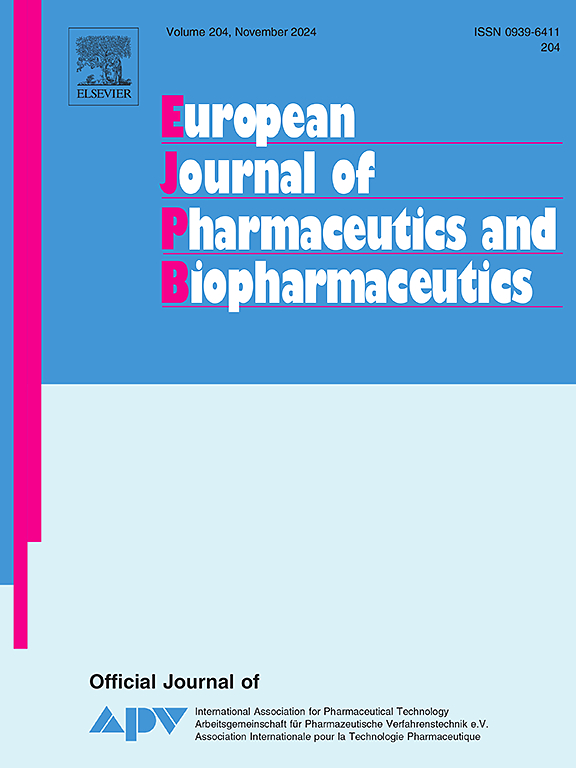Impact of stabilizers on particle size and dispersion behavior in biorelevant media in solid nanocrystal formulations
IF 4.4
2区 医学
Q1 PHARMACOLOGY & PHARMACY
European Journal of Pharmaceutics and Biopharmaceutics
Pub Date : 2025-01-25
DOI:10.1016/j.ejpb.2025.114651
引用次数: 0
Abstract
Nanocrystalline formulations typically contain stabilizing additives to minimize the risk of particle growth or agglomeration. This risk is particularly relevant when the nanosuspension is converted into a solid drug product as the original state of the nanosuspension should be restored upon redispersion of the drug product in vivo. In this work, the behavior of different nonionic and anionic surfactants in solid nanocrystalline formulations and their effects on redispersibility under biorelevant conditions were investigated. For this purpose, nanocrystalline formulations of basic (itraconazole, ritonavir), acidic (naproxen), and neutral (fenofibrate) API containing nonionic polymers acting as steric stabilizers combined either with anionic (sodium dodecyl sulfate, deoxycholate sodium, docusate sodium) or non-ionic surfactants (polysorbate 80, vitamin E-TPGS) were manufactured by nano-milling. These formulations were turned into a solid drug product by lyophilization and their redispersibility was tested by dispersing them in biorelevant media with different pH values and by characterizing their particle size distribution (PSD) and surface charge. In the absence of an anionic surfactant, it was difficult to achieve particle sizes below 500 nm. However, formulations stabilized anionically were at risk of agglomeration in gastric media. For basic API, the agglomeration was reversible for formulations containing sodium deoxycholate after increasing the pH from acidic to neutral levels, but it was found to be irreversible for those containing sodium dodecyl sulfate and docusate sodium. In summary, the type of anionic stabilizer and its interplay with the physicochemical properties of the API (basic, acidic, or neutral) should be considered in the development of solid nanocrystal formulations.

稳定剂对固体纳米晶体配方中生物相关介质中颗粒大小和分散行为的影响。
纳米晶配方通常含有稳定添加剂,以尽量减少颗粒生长或团聚的风险。当纳米混悬液转化为固体药物时,这种风险尤其相关,因为药物在体内再分散后,纳米混悬液应该恢复到原始状态。在这项工作中,研究了不同的非离子和阴离子表面活性剂在固体纳米晶配方中的行为及其在生物相关条件下对再分散性的影响。为此,通过纳米研磨,制备了碱性(伊曲康唑、利托那韦)、酸性(萘普生)和中性(非诺贝特)原料药的纳米晶配方,这些原料药含有非离子型聚合物作为立体稳定剂,与阴离子(十二烷基硫酸钠、脱氧胆酸钠、docusate钠)或非离子型表面活性剂(聚山梨酸酯80、维生素E-TPGS)结合使用。将这些制剂通过冻干制成固体制剂,并将其分散在不同pH值的生物相关介质中,通过表征其粒径分布(PSD)和表面电荷来测试其再分散性。在没有阴离子表面活性剂的情况下,很难达到500 nm以下的粒径。然而,阴离子稳定的配方在胃介质中有团聚的危险。对于碱性原料药,当pH由酸性提高到中性时,含有脱氧胆酸钠的配方的团聚是可逆的,但对于含有十二烷基硫酸钠和docusate钠的配方,团聚是不可逆的。总之,阴离子稳定剂的类型及其与原料药的物理化学性质(碱性、酸性或中性)的相互作用应在固体纳米晶体配方的开发中加以考虑。
本文章由计算机程序翻译,如有差异,请以英文原文为准。
求助全文
约1分钟内获得全文
求助全文
来源期刊
CiteScore
8.80
自引率
4.10%
发文量
211
审稿时长
36 days
期刊介绍:
The European Journal of Pharmaceutics and Biopharmaceutics provides a medium for the publication of novel, innovative and hypothesis-driven research from the areas of Pharmaceutics and Biopharmaceutics.
Topics covered include for example:
Design and development of drug delivery systems for pharmaceuticals and biopharmaceuticals (small molecules, proteins, nucleic acids)
Aspects of manufacturing process design
Biomedical aspects of drug product design
Strategies and formulations for controlled drug transport across biological barriers
Physicochemical aspects of drug product development
Novel excipients for drug product design
Drug delivery and controlled release systems for systemic and local applications
Nanomaterials for therapeutic and diagnostic purposes
Advanced therapy medicinal products
Medical devices supporting a distinct pharmacological effect.

 求助内容:
求助内容: 应助结果提醒方式:
应助结果提醒方式:


